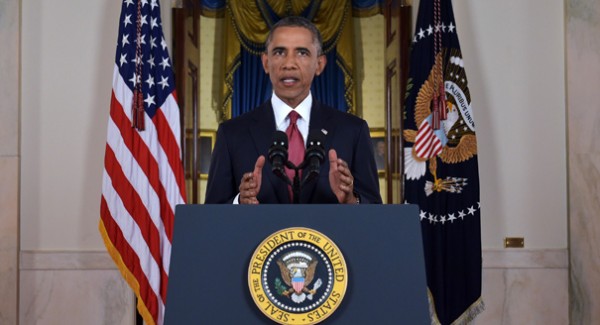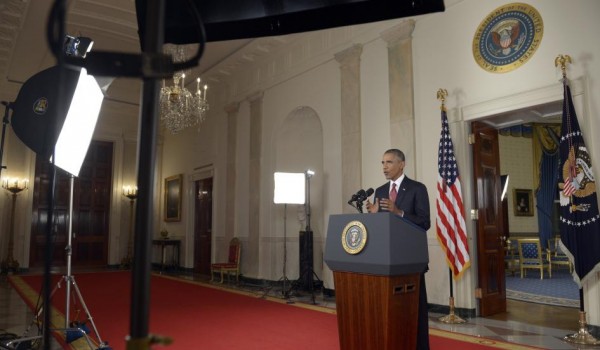Notes
As Obama *Takes Stand* Against ISIS, What Ever Happened to Oval Office Address?
After President Obama delivered yet another one of his weird, standing at a podium televised speeches last night, several people were wondering whatever happened to the classic Oval Office Address, that monument to our rhetorical youth. So far as I can tell, the story goes something like this.
The advent of television roughly coincided with that of the Cold War and presidents took full advantage of that fact. When they needed to speak to the nation on important matters, they generally sat at a desk in the Oval Office, sometimes with a desk podium and sometimes not. Most often, there was some sort of backdrop–a curtain or whatever–with flags on either side. Reagan skipped the backdrop and showed us the lovely view out the back. Most of us remember his speeches as the norm.
That style reflected the Cold War. It was a bipolar world and the president led freedom’s forces from his command center, the White House, and when he spoke to the American people, it was from that platform. We could rest assured that the leader of the free world was doing his job from where he was supposed to be.
But as the world fragmented, so, too, did presidential public address. The end of the Cold War meant that the president had to attend to multiple problems and peoples and, to show his management of those issues, he often traveled to those places or spoke from scenes designed to reflect our concerns. Of course, this happened during the Cold War–the Berlin Wall was a favorite backdrop for Cold War presidents–but that change accelerated at the Cold War’s close.
In addition, Ronald Reagan had trained in movies, hosted television shows, and regarded the camera as his best friend. If you haven’t tried it, giving a speech straight into the unblinking eye is hard. Reagan learned to do it better than anyone. As a result, I suspect, subsequent presidents did not want that comparison.
H.W. Bush soldiered manfully on, as he did with nearly everything in his life, but the baby boomers put an end to the Oval Office address. Clinton sometimes used it, esp. for foreign policy statements, such as his speech announcing the Bosnian peace accord, but more often found other venues. In fact, he loved the State of the Union and tended to reserve major policy statements for that venue. W., too, hated the Oval Office speech. Both, I think, needed people–needed audience reaction, needed to be able to connect to the people in order to deliver a speech effectively. Obama has followed in their footsteps. I also suspect that the Obama administration finds something irretrievably old-fashioned about the sit at the desk speech in an Internet age.

I think it’s a mistake. Many people still–and always will–question Obama’s legitimacy as the president of the United States. When he can, he should invoke the iconography of the office in support of his credibility. Particularly when he suffers from low approval ratings, the visual reminders of his office’s authority would enhance his standing with the American people. But for whatever reason, he seems remarkably reluctant to do so. And thus you get these ridiculous speeches, when it seems as if he’s standing at a podium in his living room delivering a speech to no one.
— John Murphy
John Murphy, Associate Professor of Communication, University of Illinois, studies the history of American Public Address and political rhetoric. He’s interested in just how political languages collide and influence each other over the course of US history. He’s written on John and Robert Kennedy, Richard Nixon, Bill Clinton, Martin Luther King. Jr. and George W. Bush. You can follow his blog, a “must read” after most significant presidential addresses (with the occasional segue to baseball) at OratoricalAnimal.
(photos: Saul Loeb/Pool via Bloomberg/Getty. caption: U.S. President Barack Obama speaks during a televised address at the White House in Washington, D.C., U.S., on Wednesday, Sept. 10, 2014. Obama pledged a relentless campaign to destroy Islamic State extremists in Iraq and Syria, with Middle Eastern allies such as Saudi Arabia and Jordan playing crucial supporting roles.)



Reactions
Comments Powered by Disqus